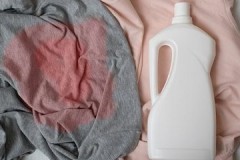Useful tips on how to gently and delicately wash a white, black and colored blouse
 How to wash a blouse so that it becomes clean and the thing itself is not damaged depends on a number of factors.
How to wash a blouse so that it becomes clean and the thing itself is not damaged depends on a number of factors.
Most of the models of this women's clothing are made of delicate fabrics, have a complex cut and require appropriate handling.
How to wash a blouse (white, silk, etc.) in the washing machine, what to do if the item has sat down after washing? You will find answers to these and other questions in the article.
Content
Is it possible?
On blouses there is always a label indicating the rules for processing the product... Some of the fabrics are not machine washable, some can only be dry cleaned.
Washing machine
Most blouses are machine washable. The exception is those that are sewn from chiffon, natural silk or have a complex decor... Only an undamaged item can be sent for washing. Stains are removed in advance.
Mode
 For blouses, the choice of washing mode is almost always limited to "delicate".
For blouses, the choice of washing mode is almost always limited to "delicate".
An exception may be:
- blouses, sewn on the principle of men's shirts, and having only cotton in their composition - for "cotton";
- made of dense synthetics - for "synthetics";
- from artificial silk - on "silk".
Temperature
The main source of information regarding temperature selection is the product label. It indicates the temperature indicator, which is recommended by the manufacturer itself, and which cannot be exceeded.
Limit: from + 30 ° C to + 60 ° C when it comes to tight white shirts... Considering this information, after the desired mode has been selected, the value of the indicator should be adjusted.
Spinning
 You should not set high spin rates, even for cotton fabrics. Intense impact can damage the material and lead to deformation.
You should not set high spin rates, even for cotton fabrics. Intense impact can damage the material and lead to deformation.
It is advisable to wash any blouse on the minimum spin... Or without it - if the matter is thin.And do not use the "drying" function.
The blouse, after being taken out of the washing machine, should not be practically dry - this is harmful to the material.
Detergent
Powders and gels are traditionally used for washing in a machine. When processing blouses gels are preferable to powders, as they dissolve more easily in water and do not leave sediment... When choosing, you must take into account the color of the blouse.
Hand wash rules
Washing blouses by hand is preferable to machine processing, especially when it comes to thin translucent chiffon blouses or delicate silk ones.
Washing procedure:
- The blouse is inspected for damage. If there are any, the elimination of defects should be done before washing.
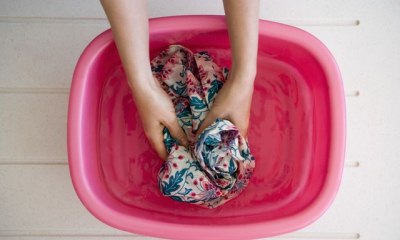 Warm water is poured into the basin.
Warm water is poured into the basin.- Dilute the detergent.
- Dip the thing.
- For the best washing effect, the blouse can be soaked for a short time for about 30 minutes.
- The thing is carefully washed.
- Rinse.
- Squeeze effortlessly. For delicate fabrics, spin by wrapping the blouse in a terry towel.
- Send to dry.
Fabric type: what does it affect?
Women's blouses are made from a variety of materials. Each species should have its own approach.
Chiffon
Feminine, weightless and very beautiful chiffon clothes are recommended to be washed only by hand. The water temperature for such products should not exceed + 30 ° C.
Regular detergents are not suitable for such blouses, it is necessary to use only such products that are intended for delicate fabrics.
It is impossible to squeeze, and even more so to twist, the blouse - the material will not withstand such a test.
Silk
Natural silk is one of the delicate materials that you need to be careful with. It is necessary to adhere to the following recommendations:
 for washing, choose a gel, not a powder;
for washing, choose a gel, not a powder;- no need to take the item to dry cleaning;
- you should not use bleaches, especially with chlorine;
- ironing at a low temperature immediately after washing;
- the blouse can be washed at a low temperature - up to + 40 ° C;
- spin - very careful, without twisting - it is better to let the things just drain.
Artificial silk is processed like synthetics.
Synthetics
A blouse made of synthetics, if washed incorrectly, can lose its shape. To avoid damage to the fabric, it should be remembered that:
- spinning must be set to the minimum;
- wash the blouse only after fastening all the buttons, zippers, Velcro and buttons;
- turning inside out is a mandatory ritual;
- the use of stain removers should be limited.
Cotton
A blouse made of cotton fabric is practical, pleasant to the body. It is not difficult to wash it if you follow these recommendations:
- do not install the dryer in the machine;
- using stain removers and bleaches is possible with caution;
- spinning - up to 800.
Read about how to wash cotton here.
Features for different color
If several things are sent to the wash, and among them are blouses, then the whole pile needs to be sorted. Blouses differ from each other not only in the type and density of the material, but also in color:
 Pure white blouses must be washed separately, using a white detergent to accentuate whiteness and help preserve color, as they contain bleaching ingredients.
Pure white blouses must be washed separately, using a white detergent to accentuate whiteness and help preserve color, as they contain bleaching ingredients.- For processing black fabrics you also need a powder or gel designed for products of this particular shade. It will prevent discoloration.
- For other colors any all-purpose powder or gel will do. It can, if necessary, also be used for processing both black and white blouses, but this is not desirable.
If a thing fades
If the blouse fades, then you should not wash it with other things, even of a similar shade.For such a product, the best option is a low water temperature (up to + 40 ° C) and the use of a high-quality detergent that works even at low temperatures.
If there is only one such blouse, you can stretch it with your hands or start the machine with just one thing.
They are sent to the drum along with the blouses and are processed on a delicate mode. For one cycle, 3 such napkins will be enough, which will absorb excess paint.
Prevent strong shedding on new fabric, and cure paint Pre-soaking things for an hour in a vinegar solution will help (1 tbsp is needed for 5 liters of water).
Removing stains
Removing stains from blouses is not an easy task. It is advisable to check the selected composition on an inconspicuous area before use.
Coffee
 To fight the stain you will need:
To fight the stain you will need:
- glycerol;
- ammonia;
- water.
Operating procedure:
- Measure ¼ glass of water into a container.
- Add 1 tbsp. l. glycerin.
- Add 1 tsp. ammonia.
- Stir.
- Sponge the solution onto the stain, moving from the edges of the stain to the center.
- Leave for 10 minutes.
- Rinse.
- Wash.
Iodine
Cope with a stain from iodine a recipe based on ammonia and hydrogen peroxide will help.
- Pour ¼ glass of water into a container.
- Add 1 tsp. ammonia.
- Pour in 2 tsp. peroxide.
- Mix.
- Using a sponge, rub the stain.
- Rinse the blouse.
- Wash.
Berries
 To remove the stain, you need to prepare:
To remove the stain, you need to prepare:
- glycerin (5 tbsp. l.);
- egg yolk (1 pc.).
Method description:
- Mix both ingredients.
- Apply the resulting mixture to the stain.
- Leave for a couple of hours.
- Rinse with warm water.
Fat
To remove stains from light-colored blouses the following solution is prepared:
- water (1 glass);
- ammonia (1 tbsp. l.).
Procedure:
- Mix 2 components in a prepared container.
- Using a cotton pad, wipe the greasy stain.
- A piece of white cotton fabric is placed on top of the spot.
- The affected area is ironed with an iron.
Another easy way to remove a greasy mark:
- Sprinkle the stain with starch.
- Rub with a damp towel.
Ink from pen
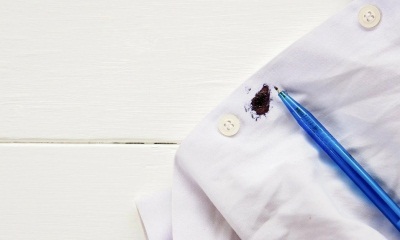 Prepare glycerin and salt in advance. In the process of removing the stain, 2 solutions will be used.
Prepare glycerin and salt in advance. In the process of removing the stain, 2 solutions will be used.
First solution:
- pour ¼ glass of water;
- add 5 tbsp. l. glycerin;
- mix.
Second solution:
- pour 0.5 l. warm water;
- add 2 tbsp. l. salt;
- stir.
Removing the stain:
- Immerse the area of the blouse with the stain in the glycerin solution.
- Withstand 2 hours.
- Dip the stained area in saline.
- Withstand a quarter of an hour, moving the fabric.
- Rinse.
- Wash.
What if the fabric shrinks?
Deformation of the item, in particular shrinkage, can be the result of improper washing or drying. It is not possible to correct the defect in all situations.
If a blouse made of synthetics has sat down, you can try to return her appearance in the following way:
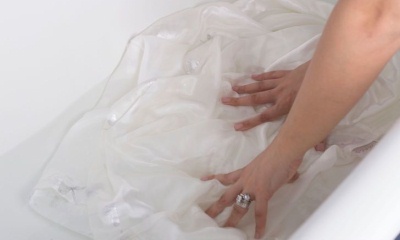 Soak the product in cold water.
Soak the product in cold water.- Hold for a quarter of an hour.
- Load into the washing machine.
- Select in the settings "delicate wash", spin - 400, water temperature - 30.
- Start washing.
- No powder is added.
A shrunken cotton or blended item can be restored as follows:
- soak in cold water for 15-20 minutes;
- shake off;
- spread out on a horizontal plane, pulling the blouse with your hands so that it regains its shape.
Correct drying
After the blouse is washed, dry it. It is convenient to do this by hanging it on a hanger. Even if the fabric is wet, it will drain.
If a street is selected for drying, then direct sunlight should be avoided... In the room, it is necessary to choose a suitable place for drying:
- dry,
- warm,
- with good air access.
Do not try to speed up the process by hanging shirts on radiators or near fires. While the blouse is still wet, flatten the garment well to avoid creases.
7 recommendations
Wash your blouse quickly and efficiently the following recommendations will help:
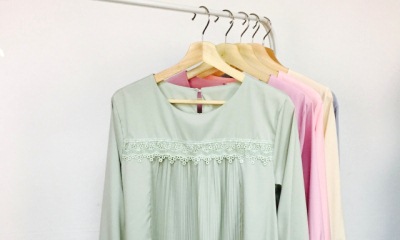 If there is a choice - to dry outdoors or at home, then it is better - in the fresh air. An exception is a dusty gas-polluted area.
If there is a choice - to dry outdoors or at home, then it is better - in the fresh air. An exception is a dusty gas-polluted area.- If you choose to wash by hand or in a typewriter, then for thin fabrics the choice is obvious - by hand.
- All work is recommended to be carried out with rubber gloves. When removing stains, the use of gloves is a must.
- Gel is preferable for working with thin tissues.
- If there is any doubt about the choice of the water heating indicator, it is better to give preference to a lower value. Better to be safe than ruining the thing.
- The number of putting on the same thing should be no more than two times. In the hot season - just one donning.
- You can only store a completely dry item.
Conclusion
Blouses need to be washed carefully, as they are delicate items that can be easily damaged. To handle the processing without any unpleasant consequences, it is recommended to study the label for the product and follow the tips specialists.

